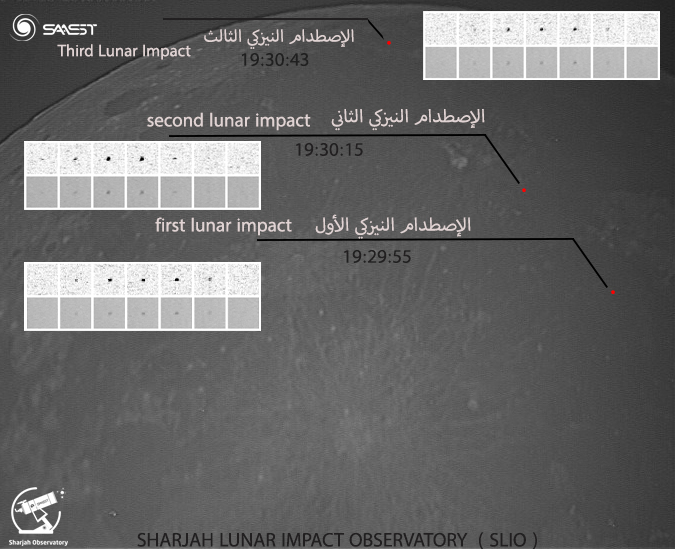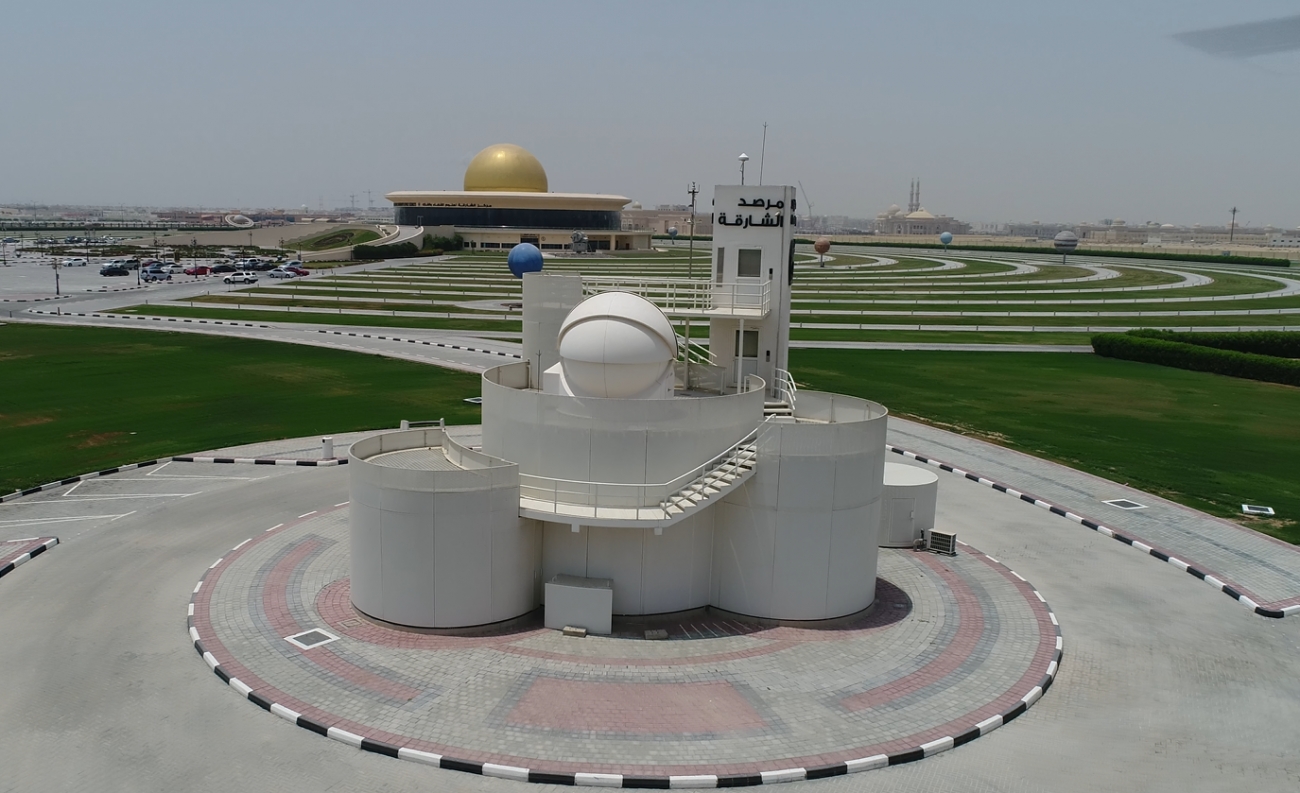His Highness Sheikh Dr. Sultan bin Mohammad Al Qasimi, Member of the Supreme Council, Ruler of Sharjah, and President of the University of Sharjah, founded the Sharjah Academy for Astronomy, Space Sciences, and Technology (SAASST) as a scientific hub that aims to disseminate knowledge of the developments, significance, and impact of astronomy and space sciences and technology.
SAASST's Sharjah Astronomical Observatory Observer and Research Assistant, Mr. Mohammad Fadil Talafha, detected rare sequential lunar impacts on January 18th, 2021.
His Excellency Prof. Hamid M.K. Al Naimiy, Chancellor of the University of Sharjah, General Director of SAASST, and President of the Arab Union for Astronomy and Space Sciences announced this observation. He added that these impacts were observed using the Sharjah Lunar Impacts Observatory Telescope (SLIO). This observatory consists of a three-meter-high dome equipped with a 14-inch Meade telescope and many sensitive instruments.
His Excellency stressed the importance of the SLIO telescope as it conducts ground monitoring of the dark part of the moon to determine the rates and sizes of large meteoroids that hit the lunar surface. The goal is to enhance our understanding of the lunar impacts' effects on space missions, which helps protect and facilitate manned space missions. Monitoring such phenomena opens the gate to study the types and effects of such impacts on the surface of the moon and how craters form over billions of years. The team working in this observatory is committed to monitoring this event and sharing results with other global observatories worldwide. SLIO also involves students in various research projects and observational missions at the Sharjah Astronomical Observatory.
His Excellency, the University Chancellor, affirmed that SAASST, thanks to the generous and continuous support of His Highness the Ruler of Sharjah, and through this great achievement confirms its capabilities in accomplishing this aspect of its scientific role. He pointed out that SAASST is moving forward with steady and concrete steps in enriching awareness and knowledge in the fields of astronomy, space sciences, and technology through its various scientific and research projects.
His Excellency Prof. Al Naimiy added that the University of Sharjah in cooperation with SAASST launched several new graduate programs in the service of these fields. Those include the Master of Science in Space Sciences and Astronomy, the Master of Science in Geographic Information System and Remote Sensing, and the Master in Air and Space Law programs. They aim to enhance students' academic and professional knowledge and provide them with the required experience in the field of astronomy and space sciences. This through working on specialized research and developing projects that support the space sector in the United Arab Emirates and the world.

For his part, Prof. Mashhoor Ahmad Al Wardat, Vice General Director of SAASST for Academic Affairs and the Sharjah Astronomical Observatory confirmed that after analyzing the time of impacts and their relative positions, the team concluded that they are a series of meteorite impacts. They resulted from the meteoroid's disintegration due to the gravitational pull of the moon as it approaches its surface. Meteoroids are fragmented, and fall in pieces scattered longitudinally and happened in several impacts, such as Comet Shoemaker-Levy's case when it approached the surface of Jupiter in 1994. Its parts were fragmented and collided with the planet in the form of a longitudinal chain. This also happened to the asteroid that hit Earth in 2008, and its parts were scattered over a wide longitudinal area in the Nubian Desert in Northern Sudan.
Prof. Al Wardat explained that the Sharjah Astronomical Observatory team is now working on a more in-depth analysis of these lunar impacts to determine the main object's source and mass. The observatory conducts various projects such as monitoring galaxies, binary stars, studying variable stars, and determining the age of star groups. All to disseminate scientific information and support research projects. Al Wardat confirmed that the Sharjah Astronomical Observatory is equipped with the best and most modern devices that enable astronomical imaging and deep sky observation. It contains several telescopes that enable researchers to study the star spectrum and monitor Exoplanets, the Sun, and their changes.
The observer and research assistant Mr. Mohammad Fadil Talafha, also stated that there are monthly scheduled observations to monitor lunar impacts using the Sharjah Lunar Impact Observatory (SLIO) telescope. It is dedicated to such observations and considered one of the most technical astronomical observations that need high sensitivity tools and require high accuracy in analysis. These impacts appear in the form of very short light flashes, sometimes reaching fractions of a second, so accuracy is crucial.
What distinguishes this series of impacts, he added, is that they occurred within a short time (one minute) and with greater brightness than usual. Also, their flash periods were relatively long, as periods of up to a quarter of a second were recorded in each impact, which is considered a long time for such events. It is important to mention that these impacts spread in the middle of the moon's dark eastern side at the time of observation and spread over a distance of 1000 km on its surface.
He added that it appears from preliminary analyses that these impacts have created new craters on the moon's surface ranging in diameter from 5 to 10 meters.
It is noteworthy that the Sharjah Astronomical Observatory has recorded several impacts during the previous period as the first observatory in the Middle East dedicated to this type of observation. It is also collaborating with the European Space Agency.



